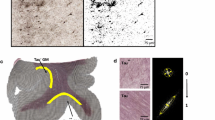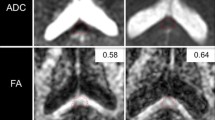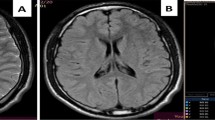Abstract
We report here two cases of diffuse axonal injury (DAI) studied by MR diffusion tensor imaging (DTI) and fibre tracking (FT) focused on the corpus callosum. In one case, DTI and FT pattern matched the diagnosis of broken white matter tracts. In the other case there was a discrepancy between DTI and FT data that showed unaltered white matter tracts with the presence of intra-cellular oedema. These data suggested that DTI and FT are able to differentiate between traumatic cytotoxic oedema and broken fibres in the case of DAI.





Similar content being viewed by others
References
Wang H, Duan G, Zhang J, Zhou D (1998) Clinical studies on diffuse axonal injury in patients with severe closed head injury. Chin Med J (Engl) 111:59–62
Atlas SW (ed) (1996) Magnetic resonance imaging of the brain and spine, 2nd edn. Lippincott-Raven, Pennsylvania, USA
Basser P, Pierpaoli C (1998) A simplified method to measure the diffusion tensor from seven MR images. Magn Reson Med 39:928–934
Westin CF, Maier SE, Mamata H, Nabavi A, Jolesz FA, Kikinis R (2002) Processing and visualization for diffusion tensor MRI. Med Image Anal 6:93–108
Fillard P, Gerig G (2003) Analysis tool for diffusion tensor MRI. MICCAI 2:967–968
Holbourn AHS (1943) Mechanics of head injuries. Lancet 2:438–441
Le Bihan D (1991) Molecular diffusion nuclear magnetic resonance imaging. Magn Reson Q 7:1–30
Provenzale JM, Sorensen AG (1999) Diffusion-weighted MR imaging in acute stroke: theoretic considerations and clinical applications. AJR Am J Roentgenol 173:1459–1467
Latour LL, Svoboda K, Mitra PP, Sotak CH (1994) Time-dependent diffusion of water in a biological model system. Proc Natl Acad Sci U S A 91:1229–1233
Basser P, Pierpaoli C (1996) Microstructural and physiological features of tissues elucidated by quantitative-diffusion-tensor MRI. J Magn Reson 111:209–219
Tievsky AL, Ptak T, Farkas J (1999) Investigation of apparent diffusion coefficient and diffusion tensor anisotropy in acute and chronic multiple sclerosis lesions. AJNR Am J Neuroradiol 20:1491–1499
Basser PJ (1998) Fibre-tractography via diffusion tensor MRI (DTMRI). In: VIth ISMRM, Sydney, Australia, p 1226
Author information
Authors and Affiliations
Corresponding author
Rights and permissions
About this article
Cite this article
Ducreux, D., Huynh, I., Fillard, P. et al. Brain MR diffusion tensor imaging and fibre tracking to differentiate between two diffuse axonal injuries. Neuroradiology 47, 604–608 (2005). https://doi.org/10.1007/s00234-005-1389-1
Received:
Accepted:
Published:
Issue Date:
DOI: https://doi.org/10.1007/s00234-005-1389-1




